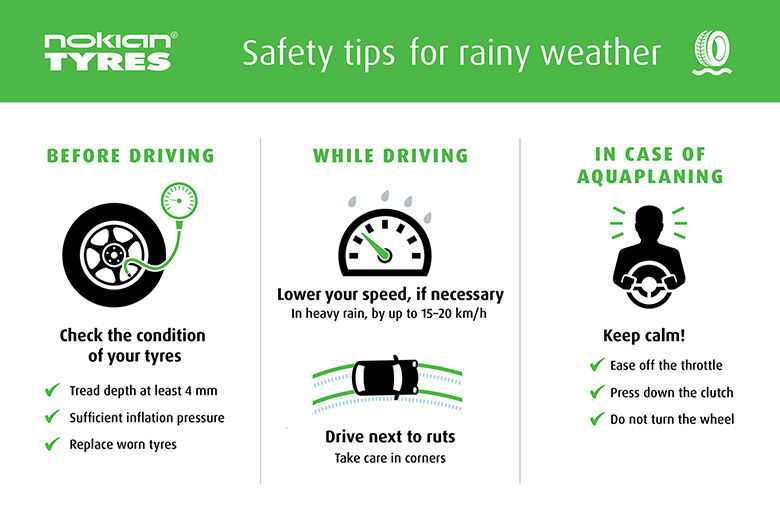Thu October 12 01:16 pm 2017 in categories Product news, Company news
Beware of aquaplaning – How to drive safely in heavy rain
Heavy rain is on its way, the autumn means darker evenings and sometimes lots of rain. Sudden showers and water puddles on roads can cause a dangerous situation for drivers if the car begins to aquaplane uncontrollably. The risk of aquaplaning is the highest in ruts and curves, where there can be several centimetres of water between the tyre and the road. However, you can drive safely in rainy weather as long as you keep in mind a few basic facts.

When it rains, two things are of paramount importance: driving speed and the condition of the tyres. When there is water inundating the road and your tyres are worn down, you should first lower your speed.
“A downpour and poor tyres is a bad combination. Then again, if you drive too fast, your car is bound to aquaplane even if you have good tyres. In heavy rain, you may need to slow your speed by as much as 15–20 km/h to allow the tread patterns to pump all the water away from between the tyre and the road,” explains Matti Morri, Technical Customer Service Manager of Nokian Tyres.
Even with good tyres, the danger of aquaplaning is real; worn tyres make aquaplaning nearly unavoidable. In a test by Finnish tyre magazine Tekniikan Maailma, a high-quality summer tyre in good condition started aquaplaning on a straight road when there was 6 mm of water on the asphalt and the car was travelling at 80 km/h. A worn summer tyre started aquaplaning already at 70 km/h and a non-studded winter tyre performed even worse.

Great demands for tyres in the fall
People often wear out their summer tyres in the autumn and buy new ones in the spring – even though the advantages of a good set of tyres are the greatest in the fall.
“The newer the tyre, the better it works under all conditions. Correspondingly, the more worn the tyre and the shallower the tread depth, the more likely you are to aquaplane. That is because the groove volume is too small to store the water between the tyre and the road,” Morri says.
The tread depth of a new summer tyre is about eight millimetres. The law allows driving on tyres with a tread depth of 1.6 millimetres, but in reality such tyres are no longer safe. Tyres should be replaced when their tread depth is close to four millimetres. When there is less tread, the aquaplaning properties deteriorate dramatically. Tyre pressure also has a huge impact on car behaviour in rainy weather. Checking the pressure regularly pays off, as excessively low pressure increases the risk of aquaplaning and affects the tyre’s driving properties.
Anticipation is the key
Aquaplaning occurs when a layer of water forms between the tyre and the road. This feels like sliding on water. The car no longer responds to the steering wheel and traction is lost. A car that cannot be steered can cause unexpected problems.
Drivers should anticipate dangerous situations and avoid driving in ruts.
“I don’t understand why so many people drive in ruts even when it’s raining – that’s exactly where the risk of aquaplaning is the highest. Driving in ruts also wears the tyres, as the asphalt is rough. That’s another reason why you should drive outside the ruts,” Morri notes.
If aquaplaning does occur despite all the precautions, it is important to remain calm and react correctly. Depress the clutch, release the accelerator, and keep the steering wheel steady. Do not turn the steering wheel, as an aquaplaning car will not respond to it.
Tips for driving safely in heavy rain
- Lower your driving speed
- Do not drive in water-filled ruts, where the risk of aquaplaning is the highest
- Drive on tyres that are in good condition and have a tread depth of at least 4 mm
- Check the tyre pressure
- If aquaplaning does occur, stay calm, depress the clutch and keep the steering wheel steady
How to react to aquaplaning
- Remain calm!
- Press the clutch down and lift off your foot off the accelerator in order to reduce speed.
- Do not turn the steering wheel from side to side; instead, point it into the direction of desired travel until grip is recovered
- Do not brake or accelerate during aquaplaning, as this will only reduce grip further.
Further information -Dangers of aquaplaning: www.nokiantyres.com/innovation/safety/dangers-of-aquaplaning/
Contact
For more information, please contact
Jaroslav Nálevka, PR manager McCann Prague, 00420 725 865 874, [email protected]
Zuzana Michalová, PR manager Nokian Tyres CE, 00420 603 578 855, [email protected]